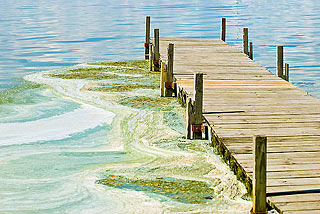Confronting toxic blue-green algae in Madison lakes
Harmful algal blooms, once considered mainly a problem in salt water, have been appearing with increasing severity in the Madison lakes, and a team of UW–Madison researchers has geared up to understand the when, where and why of these dangerous “blooms.”

Algae collects on the surface water near the south shoreline of Lake Mendota in this photo taken in June 2008.
Photo: Bryce Richter
No longer just a smelly, unsightly nuisance, the masses of blue-green algae can also exude toxins that attack the liver or nervous system.
One day, it may be possible to issue “algae forecasts” modeled on predictions of severe storms, says Katherine McMahon, a professor of civil engineering and bacteriology on campus. Eventually, she says, the results of research at UW–Madison could lead to a forecast: “Given the conditions today, we estimate an 85 percent chance of toxic blue-green algae tomorrow.”
Toxic blue-green algae are also becoming more problematic in many inland waters, including the Great Lakes.
Currently, health authorities monitor several beaches on the Madison lakes and issue warnings when they detect the characteristic blue-green color. But algae are constantly changing, McMahon says: Under favorable conditions, their population can explode. Soon, however, tiny animals called zooplankton “graze down” the algae, and the population plunges.
“Cyanobacteria are naturally present in lakes that get a lot of nutrients and are not an invasive species. But we think an increase in phosphorus from the agricultural and urban landscapes is contributing to more severe blooms.”
Katherine McMahon
“Once you recognize that not all blue-green algae produce toxins — and even the toxic ones don’t produce toxin all the time — and you have a recipe for confusion,” McMahon says. To make a good forecast, “you need to understand how these blooms originate and develop.”
Research questions abound. What, exactly, constitutes a “bloom?” Which strains of blue-green algae — technically called cyanobacteria — are toxic, and under what conditions do they produce toxins?
Various cyanobacteria have lived in the Madison lakes for at least a century, and probably thousands of years. “They are naturally present in lakes that get a lot of nutrients,” says McMahon, “and are not an invasive species. But we think an increase in phosphorus from the agricultural and urban landscapes is contributing to more severe blooms.”
At UW–Madison, experts in satellite remote sensing, bacteriology and limnology — the study of lakes — are engaged in a multi-pronged effort, in collaboration with city, county and state authorities. Richard Lathrop, of the Center for Limnology, is testing whether floating screens attached to booms like those now catching oil in the Gulf of Mexico can trap algal scum and protect beaches and bathers from toxic algae.
Colleen Mouw, a researcher at the university’s Space Science and Engineering Center, is using satellite imagery to interpret light reflected from the Madison lakes. Her goal is to develop a detection system based on the wavelength of light reflected from phycocyanin, the blue-green pigment that gives cyanobacteria their common name.
Using genetic analysis, McMahon’s lab is trying to nail down the toxicity of the 20-odd genetic variants of cyanobacteria in the Madison lakes. The bacteria make for a complex, ever-changing brew, she says. “Some are neurotoxic, some are toxic to the liver, and others may irritate the skin,” she adds.
In general, she says, drinking the water produces the most hazardous exposure to cyanobacteria, but some residents have complained of respiratory distress while water skiing. “There is a lot more to learn about when these toxins are produced and how they work,” she says.
Some of the ecological questions may be answered by Paul Hanson, a researcher at the Center for Limnology, who says, “We have to understand these cyanobacteria in the context of the entire ecosystem, and that’s a real challenge. For the harmful algae to grow, they need nutrients — nitrogen, phosphorus and trace elements — and the right temperature and light environment, and they can’t be grazed by zooplankton. The interaction of all these factors determines which part of population has the competitive advantage,” and also affects the production of particular toxins.
Lakes, Hanson says, are complex, three-dimensional environments, and making “algae forecasts” will require much time and study. “That would require us to understand the physical, chemical and biological aspects of the system. You can make a prediction based on past patterns, but if you understand the basic science of the lake, you can go a lot deeper than just making a prediction of surface scum. Understanding the mechanism well enough to make predictions is challenging, but in the long run, it’s more fruitful.”
Tags: biosciences, environment, water


